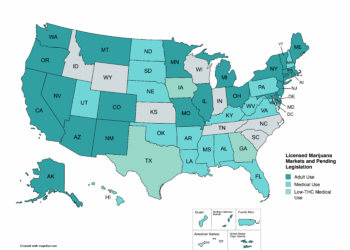Colorado’s Marijuana Enforcement Division has been slow and inconsistent when inspecting cannabis stores for violations, including sales to minors, according to a recent report by the Office of the State Auditor.
The audit was conducted in response to a “legislative request, which expressed concerns regarding a reduction in the number of underage compliance checks that the Division conducted in recent years,” according to the Aug. 7 report. Concerns were also raised about the procurement process of the state’s contract with Metrc for its seed-to-sale tracking system.
The OSA communications office did not respond to emails asking who requested the audit. But the Denver Post reported that it was state Sen. Kevin Priola, a Democrat.
“I’m glad that (auditors) pointed the finger at the department in that they dropped the ball,” Priola said, according to the Denver Post.
The auditor examined licensing and investigations data, as well as monthly MED inspection reports, from July 2018 through June 2022. It also reviewed 25 randomly selected complaints and 20 randomly selected investigations.
Among its key findings the OSA said the MED did not:
- Inspect 36% of 112 newly licensed stores within one year of approving those licenses
- Inspect 32% of 567 licensed stores that met risk factors, including 75 stores that had never been inspected
- Complete an underage compliance check on 75 of 629 stores (12%) after they appeared on a report that identified them as a risk priority
- Consistently cite retail stores for all underage sales violations
- Pursue disciplinary action against stores for 23 of 44 violations of marijuana laws and rules that affect public safety
The MED “was not always inspecting the stores according to risk, as outlined in its policies, during the timeframe we reviewed,” the report said. Auditors made five recommendations, mainly in regards to record-keeping and policy changes, to improve the prioritization process based on risk, “to ensure that stores that are being inspected are those that are more likely to be noncompliant.”
“The problems we found during this audit could erode public trust in the Division and Colorado’s retail marijuana industry because they create the perception that the Division is not regulating the industry consistently across the state,” said Laura Russell, legislative audit supervisor, in a press release.
The MED agreed with the state auditor’s enforcement recommendations and said it would work to implement them between July 2024 through June 2026. They also noted in the report and in an Aug. 7 response statement that the audit scope included the COVID pandemic when the division had to adjust the way it carried out its duties, including relying on technology to monitor sales transactions and remote inspections.
“Not all of these alternative processes were captured or considered in the audit report, and many standard processes have resumed since operations returned to more of a pre-pandemic approach in 2022,” MED said in the statement.
Since May 2022, it conducted 622 underage compliance check operations resulting in a 99% compliance rate by those retail stores, the MED added.
Not inspecting new, high-risk stores
The MED’s policy is it “will strive to inspect all newly licensed premises within one year from the date the state license is issued.” But it inspected only 40 of 112 newly licensed businesses during the audit timeframe.
The division responded in the report that not all businesses begin operating within one year because they need to obtain local approvals or other start-up delays.
The division uses a system called My License Office (MyLO) to track information about licensed marijuana businesses and employees, complaints it receives about marijuana businesses, and division investigations. MED staff enter data into MyLO, and an automated interface between MyLO and the METRC seed-to-sale system transmits licensing information from MyLO to METRC daily.
However, monthly reports do not track when stores begin operating, and staff need to search business records individually.
Additionally, auditors found that targeted inspection reports do not contain high-risk criteria, such as when a company has changed ownership or is facing criminal investigation or charges, because MyLO and METRC don’t track that information. MyLO’s investigation module also doesn’t contain complaints the division receives and specific enforcement actions. Again, staff have to research separate records.
The auditor recommended that the MED explore ways to store violations data and modify monthly targeted inspection and underage compliance check reports so they could be more useful for regional inspectors.
Inconsistent store inspections
The audit found that MED did not inspect 182 of 567 licensed stores that appeared on at least one monthly targeted inspection report, 75 of which were never inspected during the four-year period. However, one store was inspected 19 times, the report said. Auditors could not determine if that store was considered high risk.
Dan Carr, communications director for the Colorado Department of Revenue, which oversees the MED, said they can’t discuss specific names of businesses due to statutory privacy concerns and declined to comment on the OSA’s finding that the MED inspected a store 19 times.
In several counties, such as Mesa, 100% of the retailers received targeted inspections, while only 40% were inspected in Chaffee County.
When it comes to underage sales compliance, 67 stores appeared on a report because they failed a compliance check. In order to be cleared from the monthly reports, the business needs two subsequent compliant checks. Auditors said the division did not do follow-up checks on 16 of the stores and conducted one follow-up for 28. Only 23 had the required two follow-up checks.
Meanwhile the division conducted multiple checks on stores without a previous underage sale violation.
“For example, the Division conducted seven underage compliance checks at 1 store; another 9 stores were subject to six underage compliance checks each; and 36 stores each had five underage compliance checks conducted, even though none of these stores had a history of noncompliant underage compliance checks,” the report said.
Again, 100% of stores in several counties underwent an underage compliance check, while none in Bent and Alamosa counties were inspected.
The MED responded in the report that they consider other factors not related to risk, such as an underage operative’s availability to conduct inspections. They will also inspect a group of businesses in an area. And they noted the difficulty of traveling to remote retailers.
Inconsistent citations and disciplinary actions
Auditors also said the MED pursued inconsistent disciplinary actions for similar violations.
Of the 20 random investigations the OSA reviewed, seven stores were cited for selling to minors. But only three of the stores were also cited for failure to verify a customer’s age, allowing a person under age 21 to enter a restricted area, and transferring marijuana to a customer without a valid ID. Documentation was insufficient to determine why four stores were not cited for the other violations, auditors said.
It issued verbal or written warnings or did not take disciplinary action on 26 of 44 law and rule violations included in the sample, including 23 that were deemed public safety violations. Documentation in 40 of the violations did not include enough information to explain the discrepancies, auditors said.
Auditors found investigators lacked clear guidance on how they should respond when they identify regulatory violations.
“Given that Department rules exceed 500 pages, providing summarized guidance that investigators could reference during investigations could help them make real-time decisions about how to respond when they identify violations,” auditors suggested in the report.
In its written statement, the MED noted that the audit focused on specific types of investigations and disciplinary actions related to store licenses. It did not review the division’s efforts to monitor and investigate marketing and packaging to children, potential indicators of product diversion, testing compliance, adverse health reports, and contamination and unsanitary conditions at facilities.
The division has published more information on its website, including an underage sales dashboardin May and a MED Data Dashboard that includes the monthly number of investigations. It said it plans to address the audit findings during its annual rulemaking in July, and will clarify policies and procedures to investigators and licensees for greater consistency.
“This audit did have some good points on where we could improve and be more transparent than we already are,” Carr said.
He said that investigators do have discretion when it comes to enforcement, and they want to work with businesses as much as possible. But he acknowledged that their reporting stands to be improved to include the “nuance” auditors didn’t see.
“To them it’s all apples, and to us it’s apples and oranges,” Carr said.












